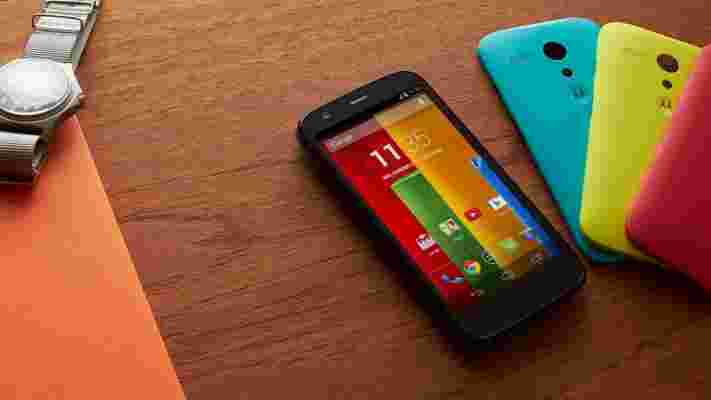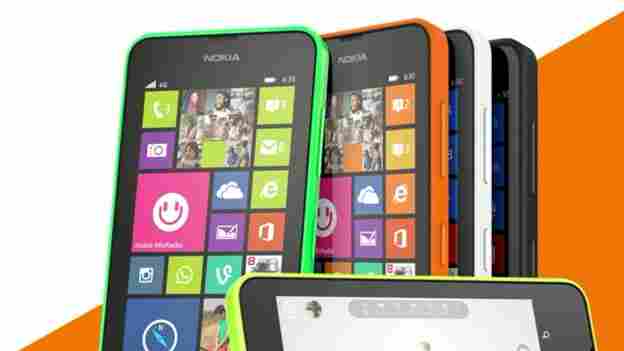Motorola continues to rebuild its brand with the launch of the Moto G today, a more affordable, entry-level successor to the customizable, US-assembled Moto X that it launched in North America earlier this year.

The new handset sports a 4.5-inch, 720p display (329 ppi), 1GB of RAM and a quad-core, 1.2GHz Qualcomm Snapdragon 400 processor. Owners will get a 2,070mAh battery and either 8GB or 16GB of internal storage out of the box with Android 4.3 (Jelly Bean). Android 4.4 (KitKat), the latest version of Google’s mobile operating system, will arrive on the Moto G in January 2014.
In the photography department is a 5-megapixel rear-facing camera with 720p video recording, doubled-up with a 1.3-megapixel shooter on the front.
Aesthetically, the Moto G is almost identical to the Moto X. It’s understated in its design, with a slightly curved back and minimal hardware buttons. Motorola is promising 19 customization options too, using interchangeable back covers called Motorola Shells. These are joined by Grip Shells – Motorola’s take on bumper cases – and Flip Shells, which cover the front and feature a small viewing window.
On paper, the specs of the Moto G are significantly lower than the Moto X, Motorola’s current flagship Android smartphone. The Moto G will be considerably cheaper than its predecessor though – the device will be available unlocked and contract free from Motorolaom in the US, for $179/£135/€169 with 8GB of storage or $199 with 16GB.
The Moto G is available today in Brazil and select parts of Europe. Motorola will then launch the device in Latin America, Canada, the rest of Europe and parts of Asia over the next few weeks. Consumers in the US, India and the Middle East will ned to wait until early January, however.
➤ Moto G
Image Credit: David Becker/Getty Images
Windows Phone 8.1-equipped Nokia Lumia 630 goes on sale in the UK on May 29 for £89.95
Microsoft has confirmed that the Nokia Lumia 630 will go on sale on May 29 priced at £89.95.

The 4.5-inch display equipped, Windows Phone 8.1-toting smartphone has a 1.2GHz quad-core processor and support for microSD cards up to 128GB in order to bolster its 8GB of onboard storage. The device will be offered via Carphone Warehouse, EE, O2, Tesco and Amazon.
Clearly, with a sub-£100 price tag, it will be going head-to-head with lower-end Android devices like the recently announced Moto E . And just like with the Moto E, if you get bored of the color of your phone, you can just swap the shell for a new one; the device will be available in orange, yellow, green, white and black.
Microsoft Research built a smart elevator that uses AI to figure out what floor you’re going to
Microsoft Research is pushing the boundaries of artificial intelligence to a whole new level. Imagine a smart elevator that can figure out what floor a person wants to go to, based on their history and other factors. Okay, now you don’t have to imagine it anymore.

In an interview with Bloomberg, Head of Microsoft Research Peter Lee explains that AI is the company’s biggest focus right now. Check it out for yourself (the elevator part starts at 2:40):
Lee elaborates how a Microsoft Research team set up a bunch of sensors in front of the elevators. These in turn watched what people did, without any additional programming and without facial recognition software, for about three months.
Over that time period, the AI system learned how people behaved and began to understand their intentions. After the training period, the learning portion was turned off, and the intelligent system could control the elevator and act on the user’s behalf.
Here’s Lee offering a specific use case:
Lee’s job is to think further ahead than just what will be the next killer device to hit the market. Most of us currently sit down in front of a computer or take out our phone on the go and operate it, but Microsoft Research is looking to the next era of computing: “We think in the future, you won’t be operating computers, but instead computers will be working on your behalf.”
See also – Microsoft Research uses Kinect to translate between spoken and sign languages in real time and Microsoft Research and the UN team up to build a computational model of ecosystems across the world
Top Image Credit: Bloomberg
